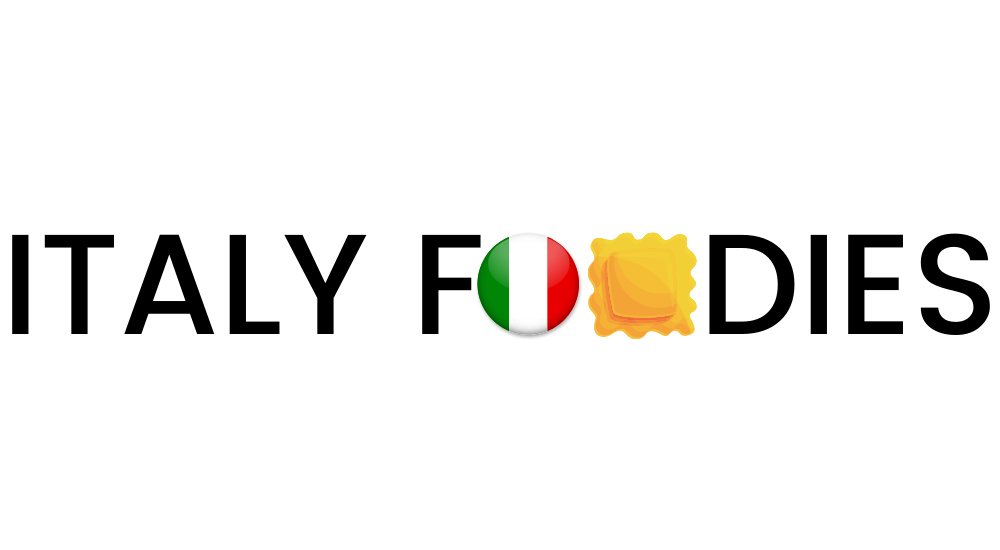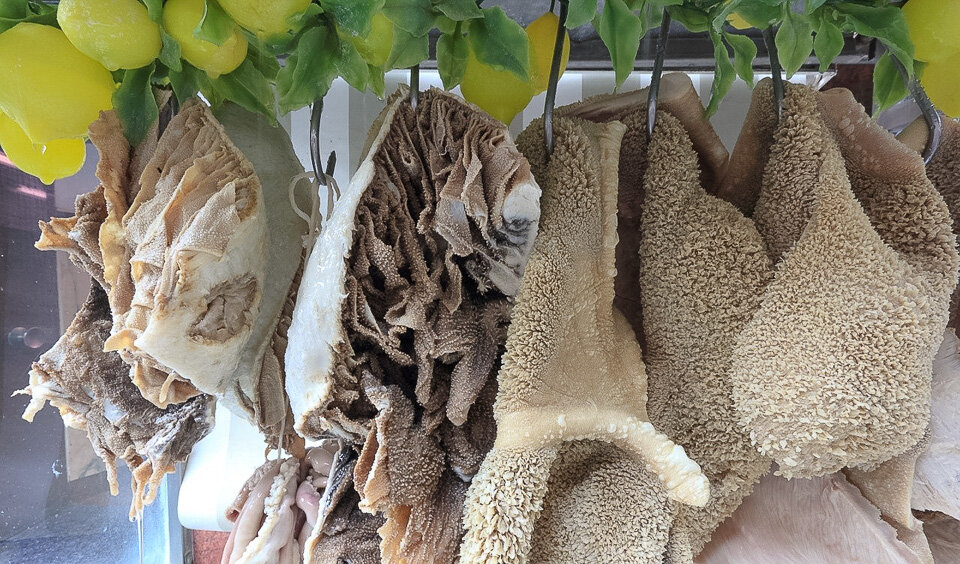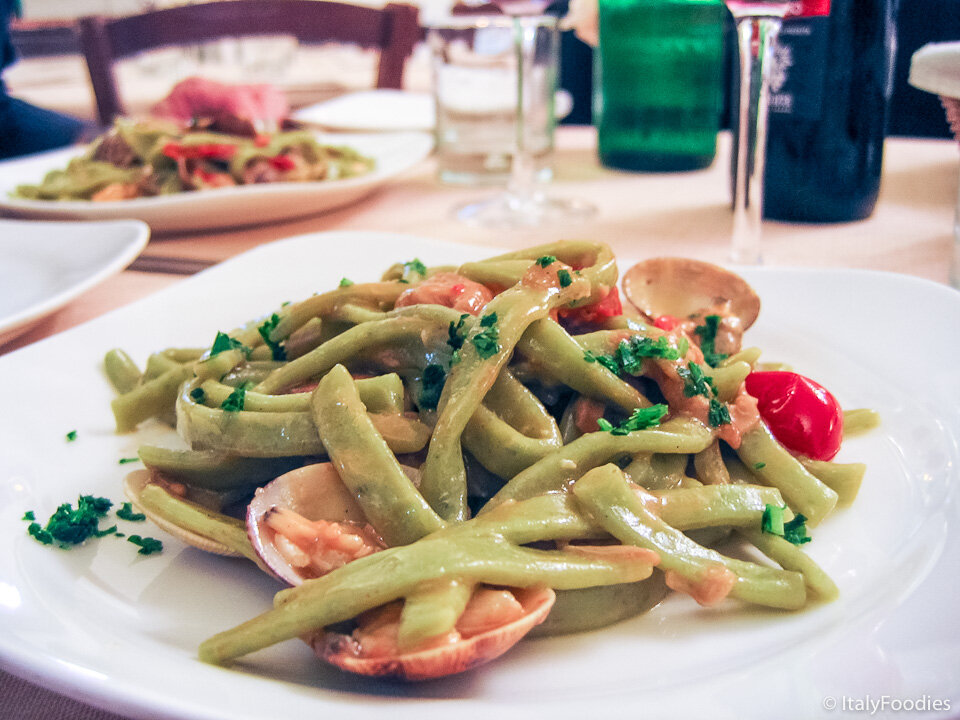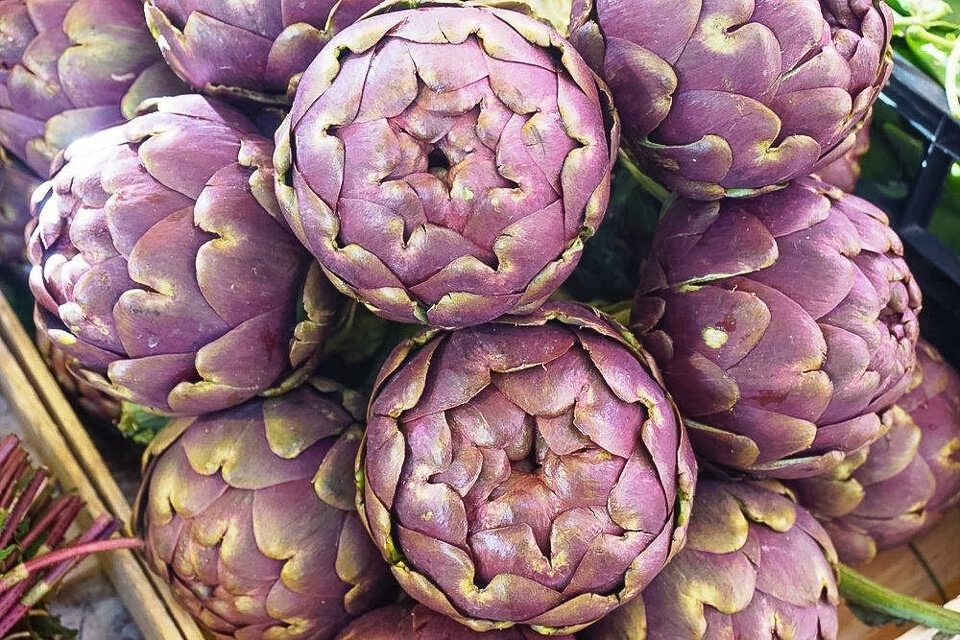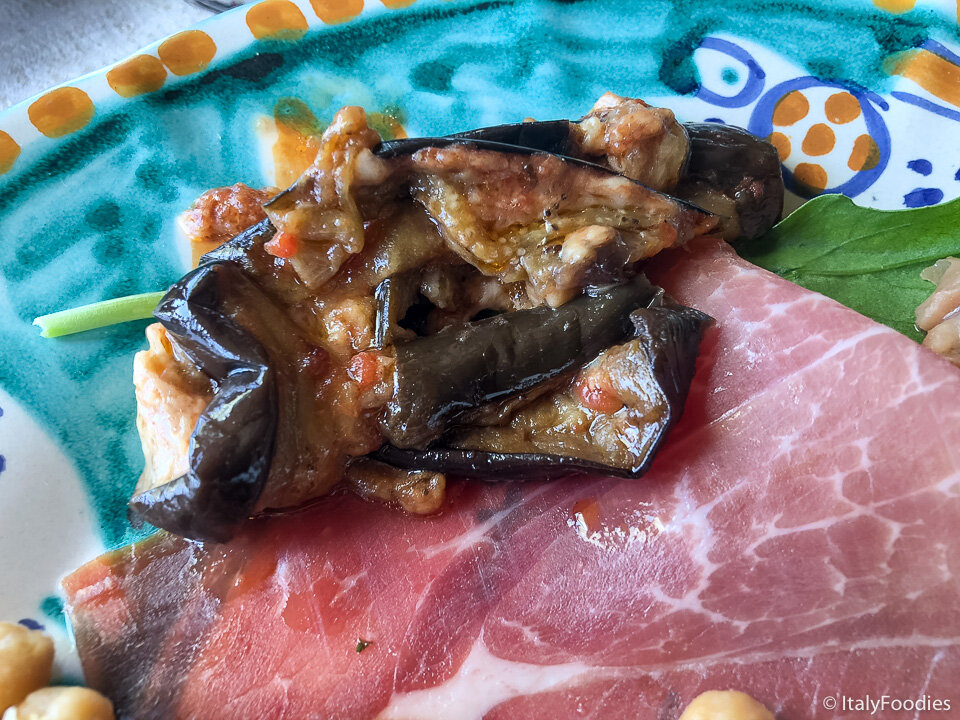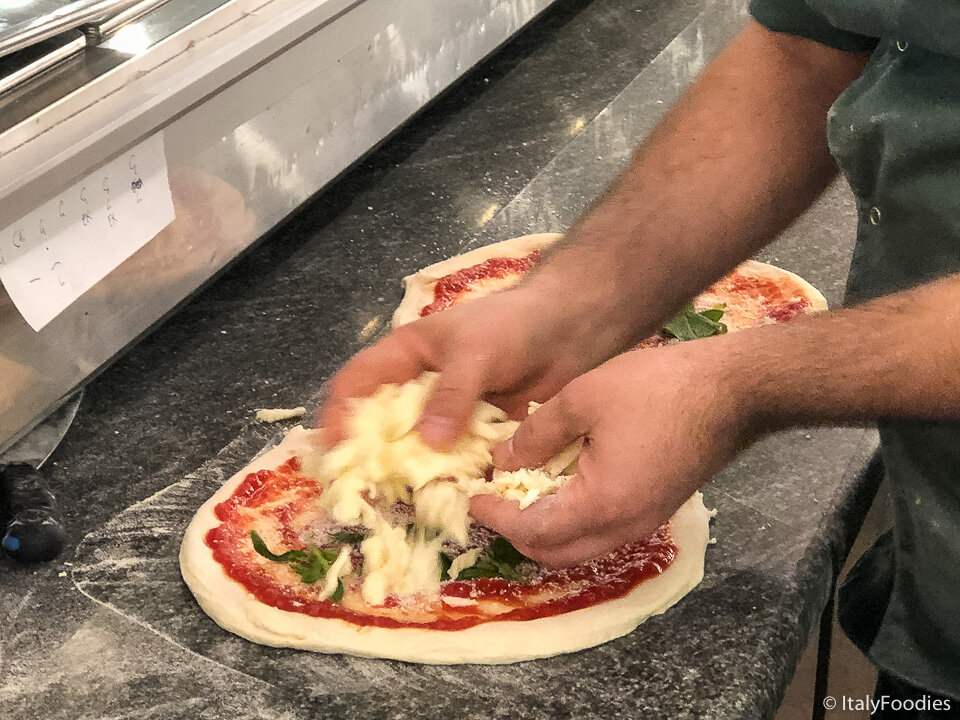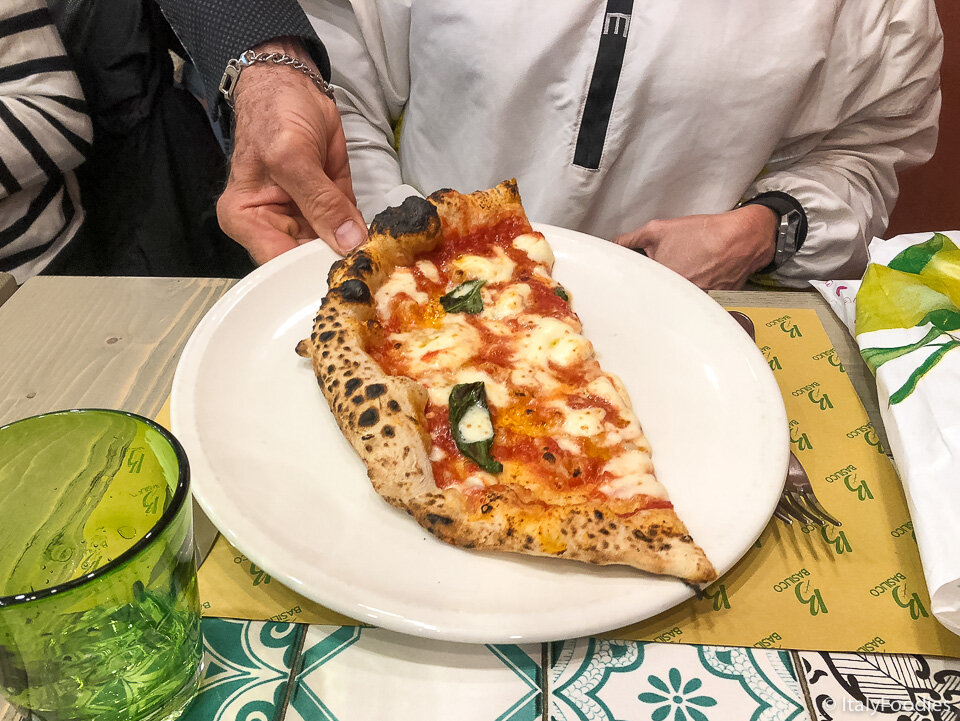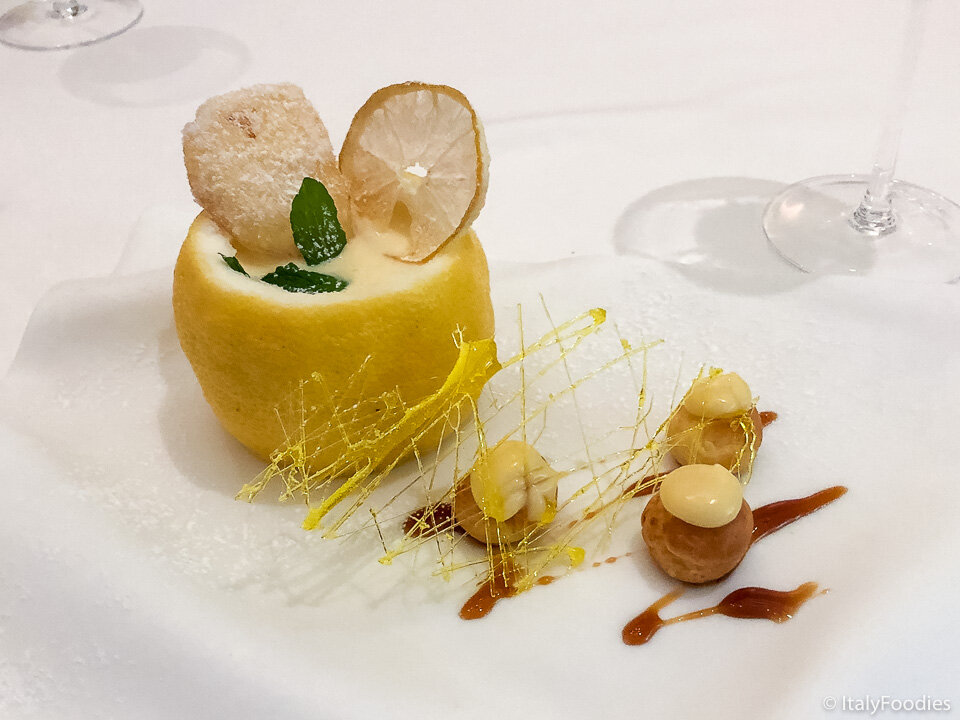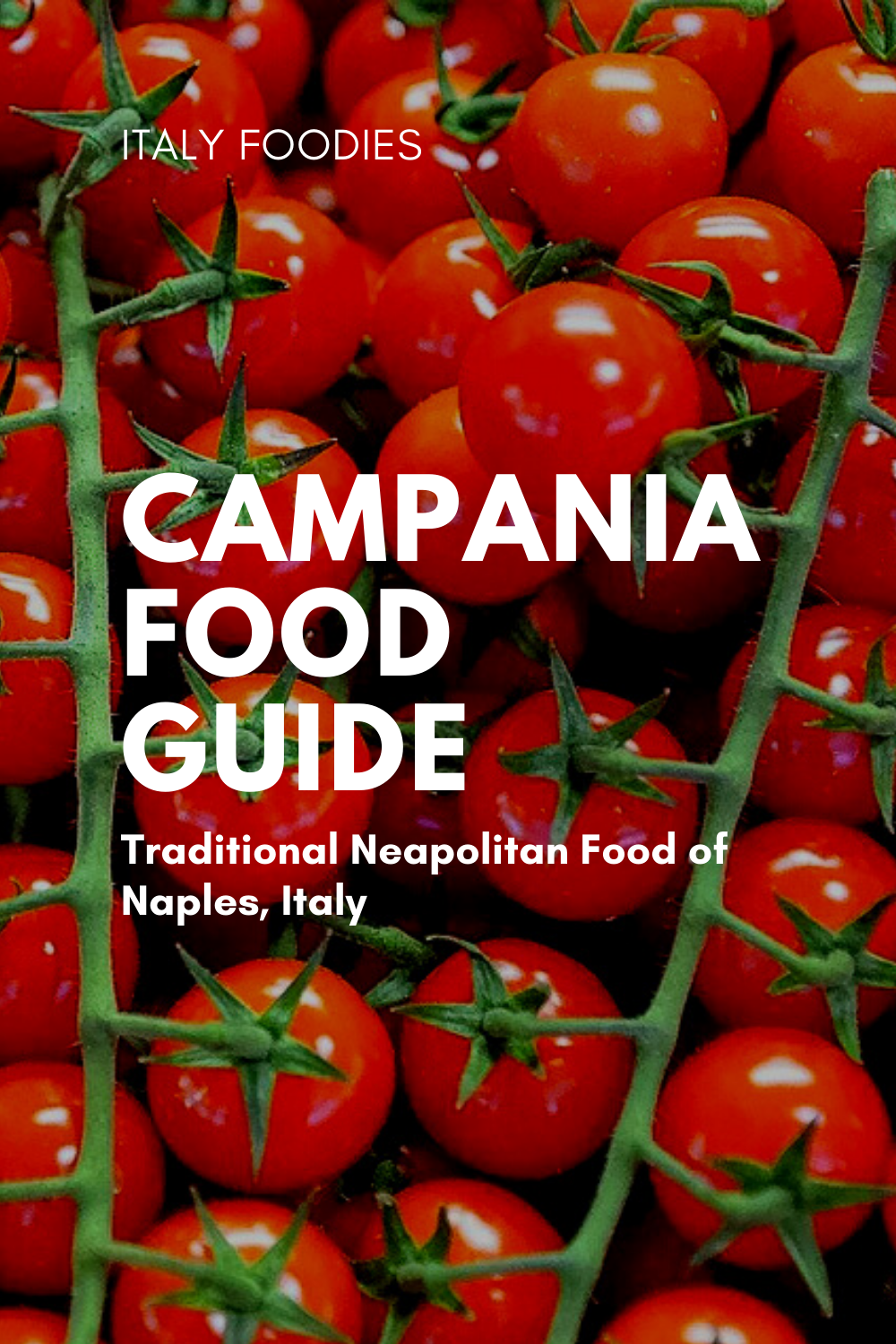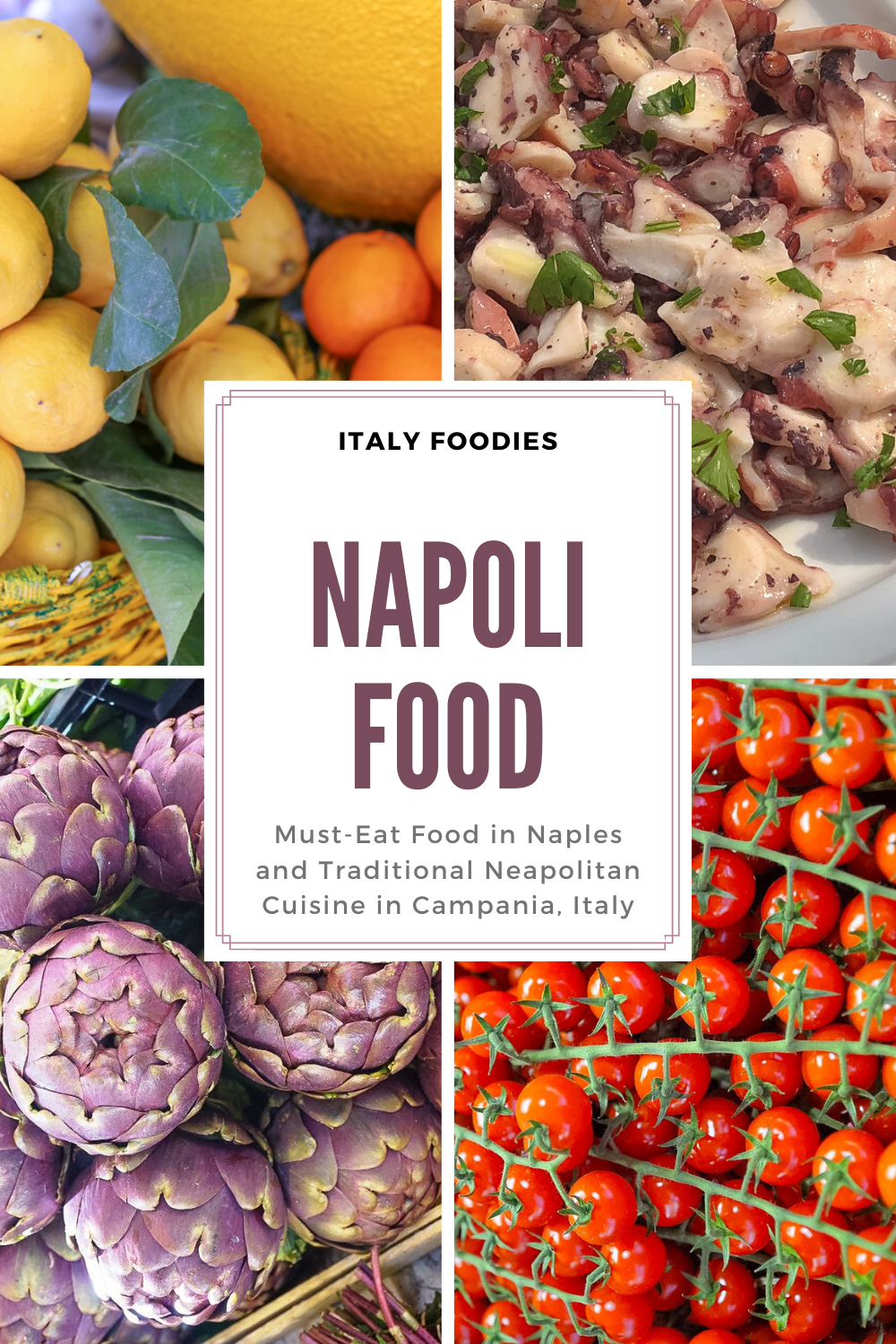Naples Italy Food Guide: 25 Campania Food Dishes and What to Eat in Naples
An essential Campania food guide to the traditional foods of Campania, Naples, Sorrento and the beautiful Amalfi Coast!
Campania is one of our favorite regions of Italy, rich in tradition and authentic culture. It’s the home of our ancestors and we’ve visited the region several times over the years.
Still, there’s something new to love every time.
If you’ve been thinking of visiting Campania but haven’t yet made plans, you should start with one of the biggest reasons to visit — Campania food.
If you’re an Italy Foodie (and we know you are if you’re reading this Naples food blog), this Napoli food guide has the traditional Italian foods you’ll find in Naples, Sorrento, Capri, Ischia, Positano, the Amalfi Coast, or any of the many small hill towns around Mt. Vesuvius.
Fresh citrus, an ever-present Campania food
Our Italian Story - What’s Yours?
Many Americans will recognize the food in Naples Italy as some of the most traditional Neapolitan food you’ve had in America. It came over during the Great Migration of the 20th century.
Before our first visit, we wondered about the local ingredients and what we’d find, what to eat in Naples and other parts of the region, and of course, where to eat the best pizza in Naples. Because, well…it’s pizza…in Naples!
Besides having some of the most delicious food in Italy, there’s another big reason why the food of Naples, Italy appeals to us — genetics.
Both of our grandfathers emigrated to America from Campania, from the small hill towns east of Naples. They handed down to us the traditions and culture of Neapolitan cuisine that we still celebrate today.
Do you have an Italian story or history too? We’d love to hear from you (drop a line below!)
Campania Food Guide
Long before we ever started traveling to Italy, let alone dream of writing about it, we were eating the local food of Naples and Campania, like many 1st and 2nd generation Italian-Americans.
Whether it’s a typical Italian Sunday dinner with family, the mid-day meal and of course only after church, or the Feast of the Seven Fishes celebrated on Christmas Eve, the Campania region embodies the healthy Mediterranean diet.
This is ironic given that much of the food of Campania stems from the hardships experienced by common people throughout the region’s history.
The cucina povera, cuisine of the poor, has survived to this day using the same locally grown ingredients.
Turns out, all this is good for us too — how wonderful!
The regional wines, foods, and traditional dishes of Naples and Campania are at their heart simple and healthy, and as rich and spicy as the culture they represent.
So what local food is Naples Italy and the Campania region known for? In this article, we’ve covered over 25 staple foods of Naples, Italy, and the traditional Neapolitan dishes made from them.
Here’s what to eat in Naples, Sorrento, Capri, the Amalfi Coast, and all of Campania.
Nervous about getting off the beaten path at Italy’s local restaurants?
Be sure and read our Essential Guide to Italian Food Phrases for ordering food in Italian!
Naples, Italy Food
It’s hard to talk about the dishes in Campania without first looking at the local Napoli food staples and ingredients that make Neapolitan cuisine unique among Italian food.
The food of the poor who were insultingly labeled in the 18th century as mangiafoglie (leaf eaters) was based on simple pastas and the available vegetables grown in the fertile coastal lowlands and the volcanic soil provided by Mt. Vesuvius which towers over Naples.
Many of these vegetables, fruits, and herbs are still farmed today and remain staples of Campania food and gastronomy.
Today, Naples and nearby Sorrento and the Amalfi Coast are world-class travel destinations and two of Italy’s best cities for food.
From excellent street food (much more than great pizza) to Michelin star restaurants, you’ll never be at a loss for great food.
What to Eat in Naples: Napoli Food Staples
Napoli Pasta
Although pasta fresca (fresh pasta that must be eaten within a few days) is made, in Naples and Campania predominantly, dried pasta (pasta secca) is the most common and abundant pasta, mainly because it’s easier to store and can be kept for a long period of time.
Most Campanians eat at least one plate of pasta each day and there’s no limit to how it is served. Although tomato sauce or a ragu is the number one topping for pasta, olive oil and garlic with herbs is also a favorite.
Think of a way to add meats, seafood, bread, vegetables, and cheeses and you’re likely to find a version of it in the region.
Some of Naples’ most iconic pasta dishes include Spaghetti, Linguine, Penne, Mostaccioli (penne and mostaccioli both have ends like a pen point but penne is ridged, mostaccioli is not) Ziti, Strozzapreti, and Paccheri, a smooth cut pasta shaped like tubes — you’ll find all sorts of dried pastas here.
The town of Amalfi boasts it’s own special pasta on the Amalfi Coast — a long flat and somewhat thick pasta called Scialatielli served with seafood. In Sorrento, you’ll find it served with tomatoes and mozzarella.
No matter where you eat pasta in Campania, you can expect it to be served al dente, or to the tooth, soft on the outside with a slight hardness to the core.
Bread
There is one bread (with a few regional variations) you’ll find just about everywhere in Campania — Baba Rustica, the savory Neapolitan Italian bread of Naples and Campania. But you won’t generally find it out in restaurants.
The bread is made of flour, milk, yeast, eggs, and oil. Once the dough is prepared, it’s filled with pieces of salami, prosciutto cotto, grated parmesan, and cubes of provolone, scamorza, or fontina cheese. Savory and uniquely Naples.
Vegetables
Greens and Lettuce (Verdura e Lattuga)
The legacy of the ‘leaf eaters’ is today enjoyed through a variety of greens grown locally and eaten mostly in salads, but also added to soups and stews or sauteed as a side dish — chicory, escarole, broccoli, iceberg lettuce, romaine, kale, chard, spinach for its sweetness compared to the more bitter greens, and the best rocket (arugula) on the planet.
Friarelli is a popular green found in Campania that’s similar to broccoli rabe, and delicious sauteed with olive oil and garlic (aglio oil).
Garlic (Aglio)
Like onions, shallots, chives, and leeks, garlic is a member of the lily family (Allium) and classified as an herb. In some areas the greens are cooked and eaten but it’s the cloves of the bulb that steal the spotlight in Campania cooking.
Used in just about every dish imaginable in the region (we’ve even seen garlic gelato), garlic lends that distinctive wonderful flavor that blends so nicely into the local cuisine.
Raw, roasted, sauteed in olive oil and added to the dish d’jour, or minced and added raw to pizzas, soups, salads, and sauces, garlic is a basic, albeit necessary, element to the zesty foods of Campania.
Besides its flavor garlic is loaded with nutrients and has many health benefits especially for the heart and circulatory system.
Tomato (Pomodoro)
Tomato lovers, rejoice! Campania is Italy’s leader in the production of tomatoes and with good reason. The region’s climate along with rich volcanic soil and fertile coastal plains make the variety of Napoli tomatoes a beautiful red and indescribably delicious.
San Marzano plum tomatoes
Many types are eaten raw or in salads, but the most common use is in making the ubiquitous salsa di pomodoro — tomato sauce — for pasta dishes and pizza. Get a load of these famous varieties of Campania tomatoes:
San Marzano Tomatoes DOP - Grown in the Sarno Valley in the rich soil of Mt. Vesuvius, the San Marzano tomato is a favored plum tomato for making tomato sauce both for pasta and Pizza Napoli. They are sweet and meaty with a thick skin and have fewer seeds than other varieties.
You’ll even find numerous tomato food festivals in Campania celebrating the San Marzano plum tomato. Look for the DOP designation, Denominazione d' Origine Protetta (Protected Designation of Origin) which guarantees that the tomatoes are indeed San Marzano tomatoes.
Principe Borghese Tomatoes - If you like sun dried tomatoes, look for these in local markets. These small grape-like heirloom tomatoes are the favorite for sun drying that grow in clusters on long vines. The vines with tomatoes are harvested and hung vertically to be eaten at a later time or just dried in the sun. Either way they are rich in tomato flavor and fun to eat.
Piennolo del Vesuvio - The Vesuvio Piennolo is a small oval shaped tomato with a unique point at the bottom. These tomatoes are hung in bunches and left to dry. They can be left hanging for several months before they are eaten and are used in canning for tomato sauce. They’re particularly great with seafood. As they dry, their rich flavor becomes more intense. The Vesuvio Piennolo has been designated as a DOP product since 2009.
Pomodori Pachino - The Sicilian cherry tomato is a favorite in salads and excellent when added to garlic, olive, oil, and basil over pasta. You’ll find cherry tomatoes in dishes at restaurants in Naples, Sorrento, Capri, and the Amalfi Coast.
Cuore di Bue - The Ox Heart tomato is huge in size and considered a delicacy among tomato lovers. The tomato has vertical ridges with a very rich taste, few seeds, and firm rich flesh. They are bright red in color sometimes with some light green or orange close to the stem.
These are enjoyed fresh and raw in Insalata Caprese with mozzarella, basil, a drizzle of olive oil, and maybe a twist from the black pepper grinder.
Capri Tomatoes - Capri tomatoes are large and heavy and deeply pleated. Named for the island of Capri, this heirloom tomato is a type of beefsteak tomato, and commonly found in the delicious Caprese sandwich (see below).
Artichokes (Carciofi)
When it comes to artichokes, you probably either love them or don’t. Or maybe you don’t want to be bothered breaking down these ‘grass peppers’ to get to the creamy and delicious choke — in which case I implore you to spend the time!
These prickly buggers are so worth it. We have a long standing love affair with carciofi, and we’ve had some of the best ever in Naples and the Amalfi Coast.
The artichoke of choice is Carciofi di Paestum PGI (Protected Geographic Origin), and is a dark green to a bright purple or violet color.
They almost remind me of peonies about to burst open in the spring — they are that wide, layered, and so pretty!
These violet artichokes shouldn’t be confused with those grown on the lagoon island of Sant’Erasmo near Venice, which are smaller in size and not as meaty. Paestum artichokes have a strong creamy flavor and are super tender.
Recipes vary from cook to cook but the most popular way of preparing them in Campania is by grilling over coals, roasting, boiling, or steaming.
With a high level of nutrients, artichokes are essential to the Mediterranean diet.
Eggplant (Melanzana)
Eggplant is most abundant in the summer and into September. There are several varieties eaten here with the favorite of Campania cooks being the long dark purple eggplant.
Zucchini (Zucchine)
This versatile squash is used in stews, with pastas, and in sauces, and the zucchini’s squash blossoms are a favorite local delicacy and absolutely yummy.
They are usually stuffed with either cheeses, sausage, or a combination of what the cook may have on hand. After stuffing they are breaded or battered and fried in olive oil. As with eggplant, the uses of zucchini in the local cuisine are unlimited.
An easy-to-make dish is sauteed or fried zucchini with your pasta of choice — gnocchi, linguine, spaghetti — served without tomato sauce and sprinkled with fresh basil.
Fruit (Frutta)
Campania produces a cornucopia of fruits such as peaches, apricots, grapes, strawberries, pears, apples, and olives (yes, they’re a fruit). But in this region it’s lemons and figs that really steal the show.
Figs
Fresh figs are everywhere in Campania, and are often served cut in half and drizzled with olive oil or balsamic vinegar. But have you heard of the white figs grown in Cilento and southern Campania? They’re a delicious regional food unique to Campania.
Locals dry them in the sun, and sometimes fill them with nuts, almonds, grapes, citrus peels and add cinnamon, fennel and other aromatic spices.
A sweet syrup called melassa is also made from the dried figs and is so yummy served with fresh ricotta cream and other types of cheese.
Lemon (Limone)
Lemons are indeed a fruit, but in Campania, they deserve their own food category. Citrus plays a major role in the areas economy and its cuisine, and no regional fruit is more renowned than the lemon.
In Campania there are two major lemon varieties, the Amalfi Lemon grown along the Amalfi Coast, and the Sorrento Lemon grown on the opposite coast of the Sorrentine Peninsula but only in Sorrento.
The Amalfi Lemon, sfusato amalfitano, is a staple ingredient in regional recipes with its addition depending only on the desired taste. It’s longer than the Sorrento lemon and two to three times larger than other lemons. We’ve seen some that were nearly the size of a small grapefruit.
All the parts of this lemon can be used in cooking — the juice, slices added to a dish, and the zested rind (which makes perfect candied lemon rind). Even the lemon leaves can be used to impart a citrusy note to smoked mozzarella cheese or meats.
Sorrento lemons, sfusato sorrentino, are equally a year round staple ingredient in regional dishes. But the bulk of Sorrento Lemons are used to make the delicious liquor unique to the area, Limoncello.
Walking the markets in Sorrento you’ll find all things lemon — preserves, marmalade, jam and jelly, lemon honey, soaps, scents, ceramics, decorative towels, an array of bottles from local limoncello producers, gelato, and granita, refreshing shaved ice drizzled with a generous amount of lemonade.
Nuts (Noccioline)
Another staple in Campania and part of a healthy Mediterranean diet are nuts. The Campania area produces over fifty percent of Italy's nuts including hazelnuts and Sorrento walnuts.
Nuts are used in baking and in many dishes as well as sweet liqueurs, Nocino made from walnuts is considered an excellent digestivo after a meal.
Meat, Fish and Seafood (Carne, Pesce e Frutti di Mare)
Because the region is so rich in fish and seafood, meat by comparison is not used as regularly as seafood although preserved meats like salami and prosciutto are enjoyed throughout the region.
Poultry, beef, pork, lamb, and rabbit are enjoyed usually by slow cooking until tender or nearly falling apart.
More meat tends to be eaten further inland. No matter the meat or seafood, all ingredients are seasonal and fresh.
Fresh seafood appears on menus and in homes all through Campania especially in Naples, Sorrento, and the Amalfi Coast. Seafood is often fried, enjoyed with pasta, added to soups and stews, and included in an antipasto. There are of course many seafood dishes.
Walk through any open market or seaside walk-up and you’ll find vendors selling Fritto di Pesce (fried fish) served in a paper cone. Cuoppo is a popular Napoli street food and generally includes crispy fried sardines and squid (calamari).
To fully enjoy add just a dash of salt and maybe a squeeze of lemon.
Cheese
Mozzarella di Bufala Campana DOP - Buffalo mozzarella is without doubt the most famous of Campania’s cheese specialties. This local delicacy is made from the milk of water buffalo bred in Salerno and Caserta.
The cheese must be made completely from the milk of domestic water buffalo and produced in Campania or the neighboring regions of Apulia and Lazio.
Fresh bufala mozzarella cheese is a famous Campania food staple
What makes it so popular? First off it tastes great, a little sweet and a little sour. Secondly, the buffalo milk is high in protein and calcium but low in cholesterol. It’s suggested that for the best experience, it be eaten within a few hours of production.
You’ll find it in antipasto, on pizza, in sandwiches, and it’s an absolute must in Caprese salad.
Ricotta di Bufala Campana - This sweet soft curd cheese made from the whey obtained in the process of making Buffalo Mozzarella. The cheese is rich, sweet, and creamy. The ricotta is used in stuffed pasta and in a variety of dishes.
Our favorite way to eat it is plain with a drizzle of honey.
Provolone del Monaco - This semi-hard cheese made from unpasteurized cow’s milk is a staple in the local cuisine. It’s shaped into a ball and then hung to age. When young, it has a mild flavor, but the longer it is aged the deeper and sharper the flavor.
Used in a number of ways, it’s often eaten with salami, prosciutto, crusty bread, and a full-bodied red wine. This is a cheese that when aged will really grab your mouth. It’s delicious.
Bocconcini - The name means ‘little bites’ and that’s just what bocconcini is. This is a small ball or egg shaped mozzarella style cheese made from either buffalo's milk or buffalo and cow’s milk combined.
They can be eaten singly, with roasted red peppers and olive oil, or combined with crushed red pepper, oregano, and olive oil. The flavor is mild.
What to Eat in Naples: Traditional Neapolitan Cuisine
So, who’s hungry?? With so many famous raw ingredients, is it any wonder that traditional Neapolitan cuisine is some of Italy’s most beloved? Here are some of the most traditional local dishes and what to eat in Naples, Sorrento, Capri, and the Amalfi Coast.
Pizza in Naples
Pizza
PIZZA! If you’re visiting Campania you’ll find pizza served in just about every town along the coast. Pizza in Napoli is the most famous food to come out of Campania, though it’s completely unique from any other part of the world.
Pizza is considered to have originated in Naples, and it’s important to understand what’s so great about it, and why it’ll ruin you forever on pizza (sorry!)
Neapolitan pizza, or pizza Napolitano is serious business and thankfully so. Pizza in Napoli will take you to a new pizza dimension, in the best possible way.
It’s one of the most popular foods al passegio (foods to go) in Italy, and one of the best Naples street foods you can have in Napoli.
The Associazione Verace Pizza Napoletana (True Neapolitan Pizza Association) dictates exactly how pizza dough must be made from the type of flour (type 0 or type 00 flour) and yeast used in the mixture, to the pH of the water.
Only the pizza maker’s hands can be used to mould the dough into the round pizza and it must not be any thicker than 3mm.
All ingredients must come from the local Campania region, and baking takes place in a domed wood fired open oven at a temperature no less than 905°F (485°C). Yikes — now that’s hot!
A lot goes into making an authentic Naples style pizza, which is why it’s among the very best pizza in the world!
Margherita Pizza
As the story goes, in the eighteenth century Queen Margherita, wife of Italy’s King Umberto I, enjoyed Pizzeria Brandi’s simple combination of tomatoes, mozzarella, and basil so much that on each subsequent visit she had the pizza maker make it just for her. And voila! the Margherita pizza was born.
We’ve never visited a pizzeria in Naples, Sorrento, or the Amalfi Coast that didn’t serve excellent pizza. Although there are some outstanding pizzerias in Naples, it’s hard to find a bad Margherita pizza.
Where’s the BEST PIZZA in NAPLES and SORRENTO? Pizzeria da Michele in Naples, and Basilico in Sorrento!
Pasta alla Genovese, a famous food in Naples
Napoli Pasta Dishes
Ragù alla Napoletana - this beloved Sunday sauce is what most Italian-Americans think of when they think of traditional pasta. Each Nonna has their own recipe handed down from generations that came before. And each is the absolute best!
Pasta alla Genovese - It’s a funny thing that one one of the most famous of all Napoli pasta dishes sometimes goes by the name Genovese — in the style of Genoa — because the dish is not made with basil pesto as in Pesto Genovese.
This Naples specialty is a tomato based sauce and is an institution in Neapolitan cuisine: every Sunday, when the family gathers for lunch, this dish is on the tables of many homes in Naples!
The Genovese pasta or Ragù alla Napoletana consists in a first course of ziti – long-shaped pasta, broken in half – topped with a white sauce of beef, pork, or veal and soft almost caramelized onions, which requires a long preparation.
The meat is cooked in the sauce until tender and are served as the main course.
Spaghetti alla Vongole - Neapolitans love clams, but toss them in Spaghetti and you have one of the most ubiquitous dishes in Neapolitan cuisine: Spaghetti with Clams. Direct from Naples Bay, the local clams are sweet and succulent, and a little garlic, olive oil, parsley and lemon is all you need to make the dish sing.
Please don’t add cheese, though. In Italy, adding cheese to seafood is like drinking cappuccino after 10am!
Pasta ai Fagioli (Pasta and beans) - You may have heard this traditional Napoli dish called Pasta Fazool — that’s what happens after generations of the Italian language loses its meaning in the New World. But it’s one and the same dish, made typically with small pasta tubes called Ditalini, and added to a bean soup with ground beef or pork.
A true peasant dish, it’s one of Campania’s most comforting dishes.
Spaghetti alla Puttanesca - Translated loosely it means ‘spaghetti in the style of a prostitute’. Recipes for this yummy dish vary a bit from chef to chef. The Neapolitan version is traditionally made with tomatoes, garlic, spices, capers, black olives, crushed red pepper, and anchovies.
The sauce is put over spaghetti or linguini. Make sure you have some crusty bread and a glass of local red wine.
Typical Neapolitan Food Dishes
Trippa alla Napoletana - made with beef tripe (lining of a cow’s stomach) stewed with vegetables, spices, and a twist or two of lemon.
Zuppa di Cozze - Fresh mussels simmered with chopped tomatoes and a splash or two of white wine, olive oil, garlic. The dish tends to be spicy from crushed red pepper and is enjoyed with crusty bread for dipping in the broth.
Similar to Zuppa di Cozze but without tomatoes is Impepata di Cozze, another popular mussel dish made with garlic, lemon, parsley, and lots and lots of black pepper.
In fact, the name of the dish literally means ‘peppered’.
Polpo Affogati - The dish is called ‘drowned octopus’. Octopus is cleaned and boiled then sauteed in olive oil with tomatoes and hot peppers. The polpo is tender prepared in this manner. You’ll also find it on menus as Polpo Affogato or poached octopus.
Parmigiana di Melanzane (Eggplant Parmigiana) - Recipes abound for this dish. The ingredients are local and simple - eggplant, mozzarella, parmigiano, tomato sauce, and of course, basil. Some cooks bread and fry the eggplant while others, us included, first salt the slices to remove excess water then fry them before assembling the layered dish.
Either way this is an easy to make delicious and filling dish.
Coniglio all’Ischitana - Take a day trip out to the island of Ischia, Capri’s neighbor and order this Ischian style rabbit for dinner. Raised on Ischia, the rabbits are native to the island. The pieces are sauteed then slow-cooked with tomatoes, white wine, basil, rosemary, and often capers.
We’ve even had it with green olives added to the stew.
Zuppa de Cozze, Naples
Napoli Street Food
Panuozzo
We had this amazing Napoli street food in Amalfi one afternoon and fell in love with it. Panuozzo is a sandwich is much like a turnover or Jamaican patty made from pizza dough.
After baking the small loaf is cut in half and filled with an eggplant, tomato sauce, and cheese combination — parmigiana di melanzane — with different cold cuts or cooked foods.
The vendor also had a few that were stuffed with cold meats but we opted for the eggplant and were glad we did. We’ve gotta go back there for another.
Insalata Caprese
The famous Caprese Salad is the island of Capri’s most famous export, and is seen on menus throughout the Campania region and beyond. But a Napoli Street Food? Oh yeah!
Our favorite way to eat the Insalata Caprese is to simply add bread to it — everything is better with good Italian bread, right?
The sandwich version is common on Capri and along the Amalfi Coast, where made at Salumeria da Aldo in the port of Capri.
That same Caprese Salad in placed in a ciabatta roll and it’s absolutely heavenly.
What About the Napoli Dessert?
We couldn’t write a Naples, Italy food guide and not include Napoli dessert now could we? Those decadent pastries, sweets, and other treats are the sweet ending to any meal, and you just have to try them in Italy.
Tempting treats like the ubiquitous sfogliatelle pastry, and perhaps the most famous Napoli dessert of them all, Baba Napoli, are beloved by dessert (and rum) lovers around the world.
We could write an entire post on Italy’s best desserts — so we did. If you’ve got a sweet tooth and want to visit Italy, don’t miss Naples and the Amalfi Coast for some of the most delectable sweet treats in all of Italy!
